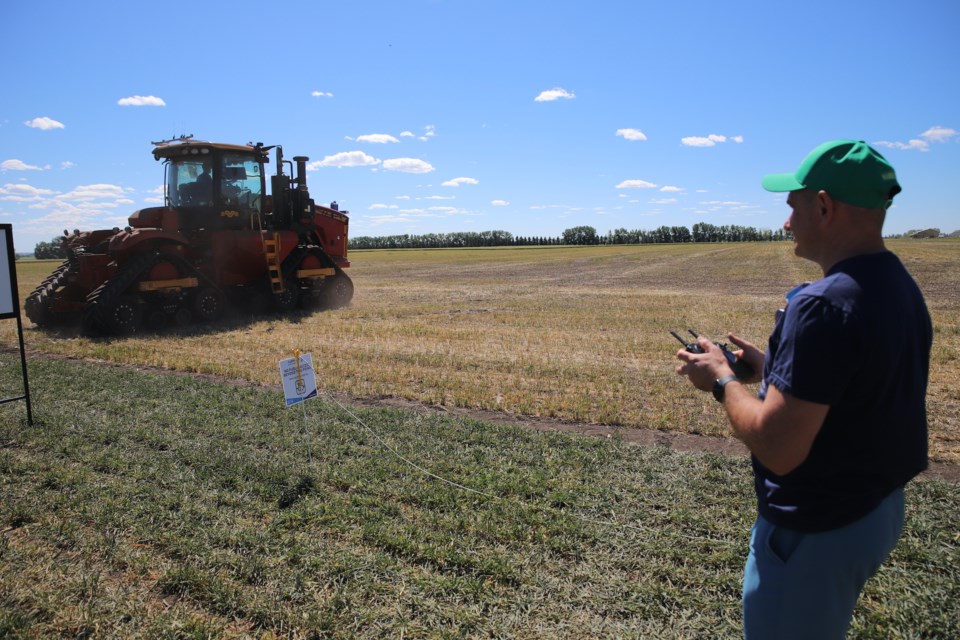OLDS — Attendees got to watch a tractor work a field all by itself, controlled with a phone app during AgSmart, the Olds College of Agriculture & Technology’s annual fifth annual outdoor agricultural display and innovation expo.
On the day the Albertan was there, July 31, about 50 people watched an autonomous tractor demonstration by Mojow Autonomous Solutions Inc., the developer of the technology.
The tractor moved up and down a field in precise rows, operated by an app on the phone of Mojow director of artificial intelligence Mojtaba Hedayatpour.
A handful of people huddled around him to watch him at work.
Company president Owen Kinch explained that the tractor was guided by Eyebox, a set of hardware and software components that can be installed on/in the tractor.
“Once Eyebox is installed and powered on, everything else can be done through a mobile application.
“Things such as moving the machine, planning and starting a job, and monitoring the state of the machine can easily be done in the mobile application,” the Mojow website says.
During an interview, Kinch said the idea of autonomous technology for farm vehicles dates back as far as 2015 when he was the first employee of Dot Technology Corp. Field testing was undertaken on his 3,000-acre farm in southeast Saskatchewan.
“My goal was to be the first person in North America to farm completely autonomous, from seeding, spraying, harvest,” he said. “We were doing all of the applications on our farm first.”
In 2019, Dot was sold to Raven Agriculture (a couple of years later Raven Agriculture was bought by Case New Holland Industrial).
At the time of the Raven purchase, Kinch and a couple of other Dot employees decided to start up their own company focusing on autonomous farm machinery.
They pitched ideas for autonomous power units to major, successful farmers.
“At the end of that conversation the question was always asked, ‘well, why couldn’t you do that with a tractor,’” Kinch said. “We never really had an answer for that, ever.”
So they decided to develop technology that could be run on/with a tractor.
“Our special sauce is we’re a mapping-first company, autonomy second,” Kinch said.
“What that means is when you look at our tractor -- the roof, front and back -- it’s outfitted with multiple cameras and lidar.
“What it’s doing is it’s scanning the environment. It’s collecting those images and we’re comparing them with our models that we’ve created.
“Basically what we’re doing is we’re understanding our environment and creating a digital representation of the farming environment around the tractor.
“It can see field boundaries, it can see sloughs, it can see rocks, it can see ruts. You can imagine what it needs to see.
“What the human needs to see today in the field to operate smartly, that’s what our cameras are doing. They’re analyzing up to 10 to 30 frames per second, depending on the speed or depending on the implement operation.”
Kinch stressed that the tractor doesn’t have to work totally autonomously.
“We have the added advantage (that) we’re a kit on a tractor. It’s still a tractor,” he said. “The human can still ride inside of it. He can still drive the tractor from field to field with the equipment.
“It doesn’t have to operate via joystick, manual joystick. You still have all the same functionality.
“Now we can add on economy,” he added, noting how precisely the tractor moves and turns, following programming instructions.
Kinch said the price of the unit hasn’t been determined yet. He said the technology is still being tested on several farms and predicted it will likely go to market by 2025.
He said it can work on hills and even deal with wet spots.
Kinch demonstrated the technology’s ability to stop if it encounters an obstacle by running out in front of it. Sure enough, the tractor stopped.
“When I jumped in front of it, it stopped, it alarmed, it gave him a notification,” he said.
In field demonstration, the kit was on a Versatile tractor, with whom the company has a deal. In the future, Kinch anticipates it will be compatible with other brands of tractors.



